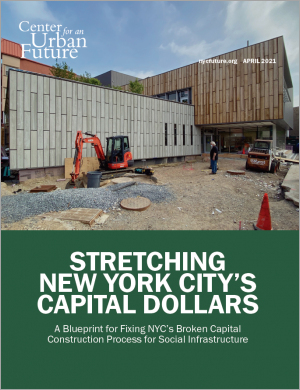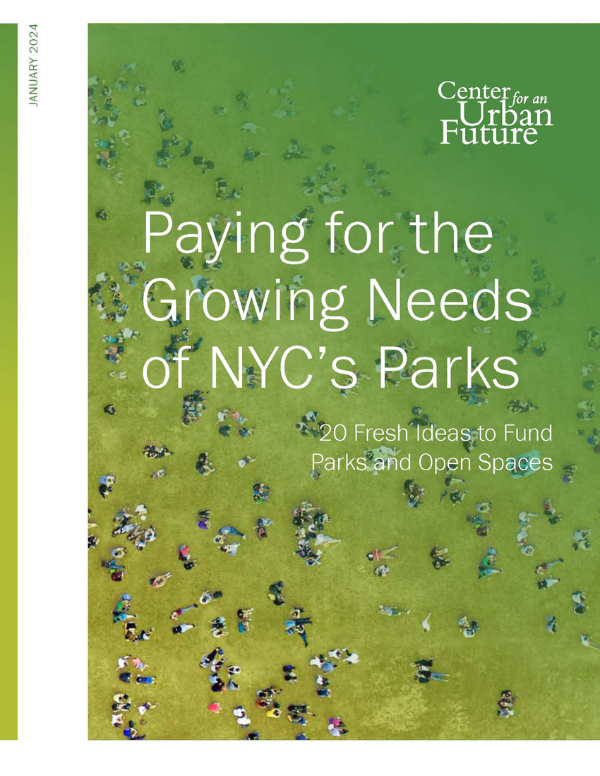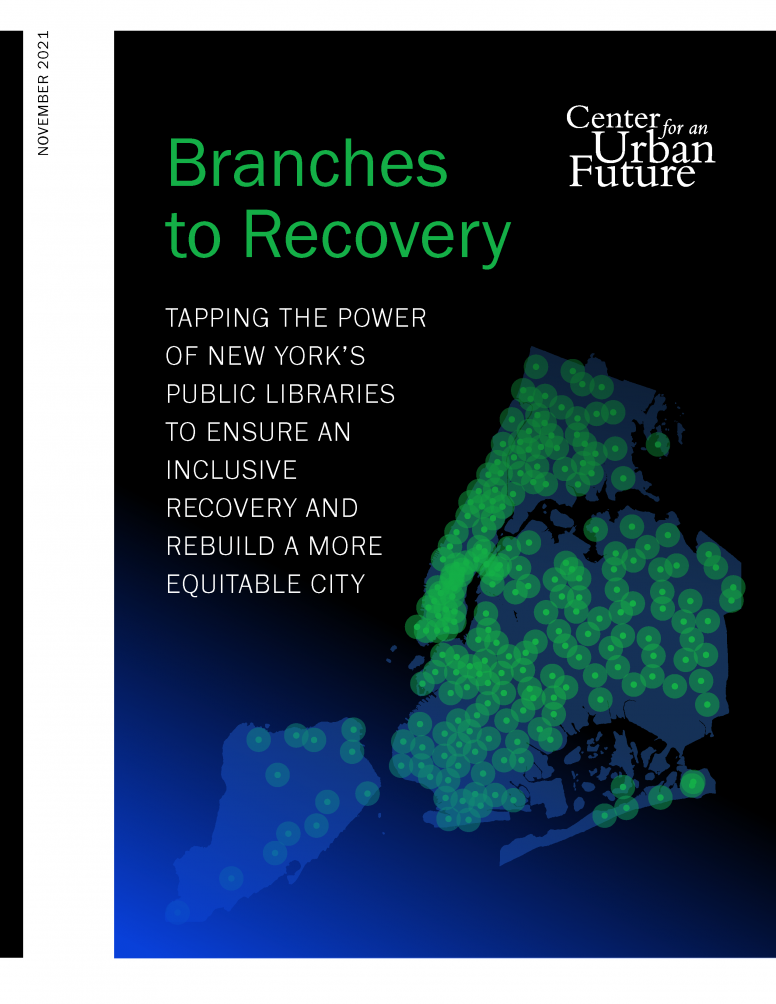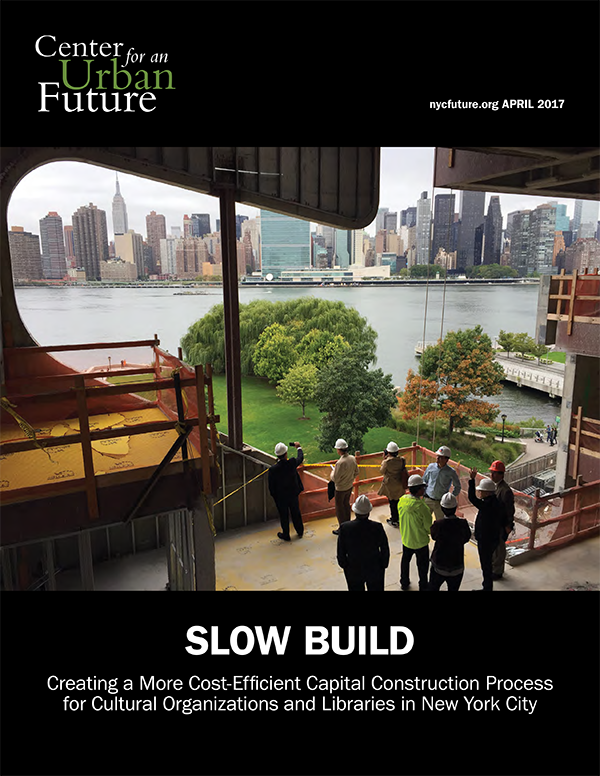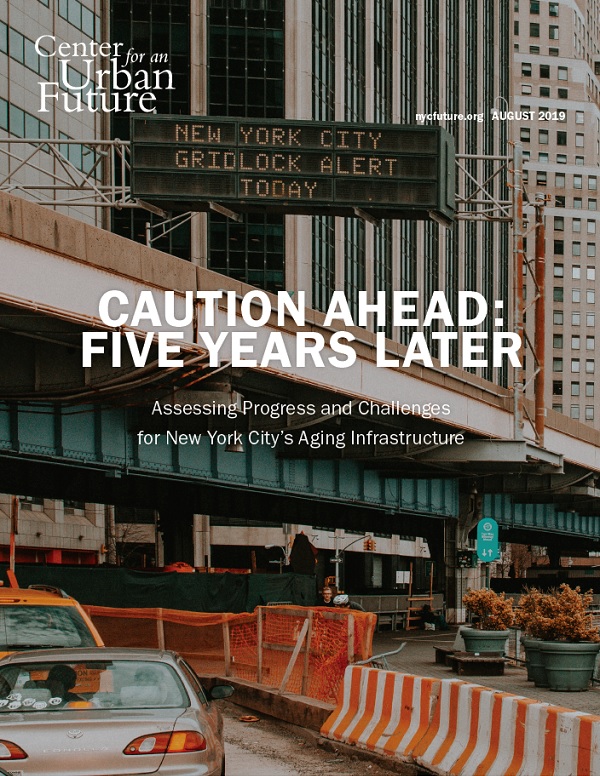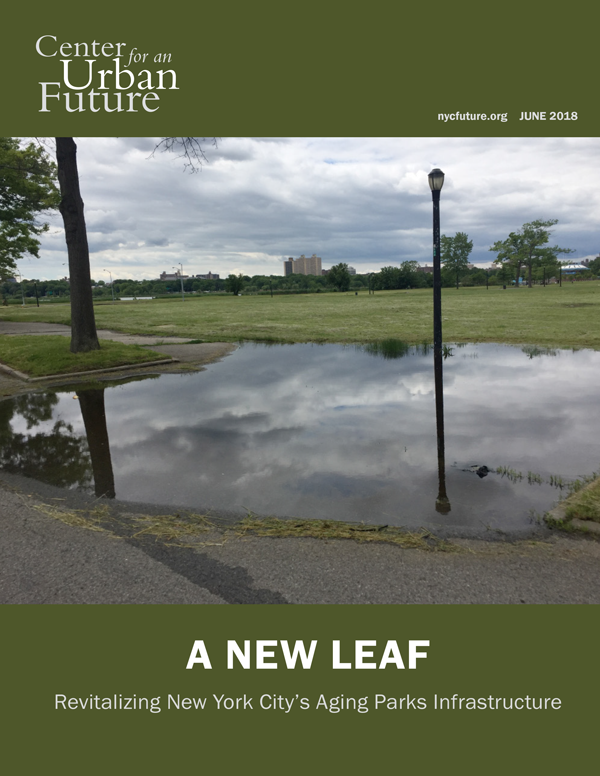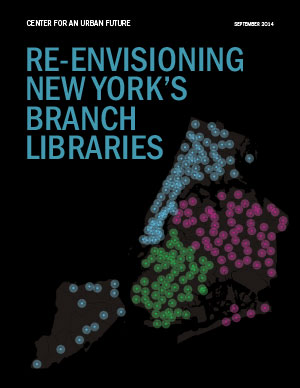Faced with an era-defining fiscal crisis, New York City’s next mayor will almost certainly need to identify new options for raising revenues and reducing costs. One of the most promising opportunities to do just that lies in fixing the city’s highly inefficient capital construction process for libraries, parks, cultural organizations, public plazas, and other critical social infrastructure.
Investing in this social infrastructure will be essential to the city’s recovery from the COVID crisis. But the inefficiencies that plague the current process have driven up costs to levels that border on absurd. A ground-up library project can easily take more than seven years to complete and cost more than $1,500 per square foot to construct, roughly triple the cost and time required to build a Class A office building.1 A park bathroom facility currently under construction will cost the city nearly $4 million.2 A heating and cooling system replacement in a branch library racked up a bill of more than $3 million.3
These are cost inflations New York can no longer afford.
The good news is that they also are not inevitable. They go well beyond the usual New York premium on construction and can be attributed to a deeply flawed and unnecessarily bureaucratic city process for managing projects.
Reforming this process could save the city at least $800 million over five years, according to our analysis of estimated cost overruns tied to major problem areas plaguing the capital construction process for public buildings. That’s nearly enough money to clear the entire backlog of state-of-good-repair needs across the city’s three library systems, or pay for 150 full-time parks maintenance workers for the next decade, or fund more than 1,300 miles of protected bike lanes.
The City’s Department of Design and Construction (DDC) has shown that progress is possible. The suite of capital reforms it launched in January 2019 has already begun to shave time off the process and lower costs. But deeper improvements are needed. To achieve them, DDC will need to continue and expand on its initial reforms. But the agency will also need far more help than it has received to date from other parts of city government that contribute mightily to the inefficiencies in the capital process, including the Office of Management and Budget (OMB).
This help is unlikely to happen without a strong push from the highest levels of City Hall. Indeed, more than any other single policy change, this report urges the next mayor to go all-in on reforms to the capital process by creating a new Deputy Mayor for Infrastructure. This official would be empowered to direct and oversee a reform process involving every agency involved in the capital project process—and possess the political muscle to hold every party accountable. Other actions are needed, too, including a reform to the state’s procurement law that mandates the selection of the lowest bidder on capital projects, which too often ends up costing the city more money despite good intentions.
Together, these changes will help the city find significant cost savings during a period of deepening fiscal uncertainty while enabling continued investment in vital social infrastructure.
Key Findings
- Reforms to New York’s capital process could save the city at least $800 million over five years, according to our analysis of estimated cost overruns tied to major problem areas plaguing the capital project design and construction process for public buildings.
- That $800 million in savings could be used to clear nearly the entire backlog of maintenance needs across the city’s three library systems or pay for 150 full-time parks maintenance workers for the next decade, or fund more than 1,300 miles of protected bike lanes.
- Library branches recently completed or in the process of construction show the need for reforms. The new Greenpoint branch cost over $1,500 per square foot. The Hunters Point library was nearly $1,900 per square foot. The new Rego Park branch is budgeted at over $2,100 per square foot. The new Far Rockaway branch will cost at least $1,800 per square foot.
- The report’s analysis of reforms enacted by DDC beginning in January 2019 finds notable improvements in front-end planning, project management, payment, avoiding change orders, and pre-qualifying contractors. As a result, the average project duration decreased from 96 months to 90 months as of June 2020—a promising achievement in a year and a half.
- However, five ongoing challenges continue to hold up the capital construction process: an underwhelming pool of contractors resulting from the low-bid requirement; delays across multiple government agencies with a role in the process; time-consuming approvals for change orders; lackluster project management; and constraints on the ability of sponsor agencies to manage their own projects.
- While projects vary, the state- requirement to award contracts to the lowest bidder can delay the average project by at least six to nine months and adds at least 20 percent to the original bill due to poor performance and delays, or at least $1 million on a typical project. With approximately 100 DDC-managed public buildings projects in construction each year, including approximately 35 library projects, we estimate that the low-bid requirement annually costs the city at least $100 million.
- Delays created by the change order process, on average, can add at least $600,000 to each project annually—on top of the cost of additional work. With approximately 100 DDC-managed public buildings projects in construction each year, we estimate that change-order-related delays cost the city more than $60 million each year.
- While some improvements to project delivery have been made, capital project staff at sponsor agencies say that too few DDC project managers are acting as the client’s best advocate and could do more to anticipate roadblocks, navigate approvals, and speed up the process. At the same time, sponsor agencies can help improve project delivery by limiting scope changes after a project is initiated.
- But other agencies have to act, too. Multiple capital eligibility reviews by the Office of Management and Budget—conducted for every budget modification—cumulatively add between four and six months to the average project timeline, while the requirements for registering contracts with the Comptroller’s Office has delayed projects hundreds of times, as initial applications are denied and returned with additional questions.
- When allowed to self-manage projects via pass-through funding, sponsor agencies like libraries can complete projects in just 20 percent of the time of DDC-managed projects, and at one-third of the cost.
New York can no longer afford to squander its limited capital funds. The city’s infrastructure needs are simply too great and capital funding too limited.
The city’s public library system alone faces nearly $1 billion in state-of-good-repair needs, not surprising given that the average branch library is over 60 years old. The same dynamic is at play across the city’s built environment, where public parks are straining to accommodate a surge in use amid the pandemic, the city’s bike infrastructure needs a major expansion, and a range of public buildings—including cultural institutions and schools—require upgrades to ventilation systems. At the same time, New York faces an urgent need to protect coastal communities from storms and sea-level rise, upgrade its broadband infrastructure, and address deteriorating conditions in NYCHA buildings across the city.
Investing in these and other infrastructure projects could give New York a crucial boost during this COVID-19 crisis, strengthening the communities hit hardest by the pandemic, creating jobs for New Yorkers who are out of work, and laying the groundwork for an inclusive recovery. But right now, the city’s broken capital construction process is standing in the way.
As we documented in the Center for an Urban Future’s 2017 Slow Build report, building a new library or cultural project in the five boroughs takes seven years to complete and costs a staggering $930 per square foot—roughly twice the cost of a Class A office tower.4 (Newer data suggest that the average cost per square foot to build a new library has risen to well over $1,500 per square foot.) The result is that the city’s limited infrastructure funds don’t stretch very far, leaving many needed projects on the drawing board and causing unacceptable trade-offs between maintaining current infrastructure and building innovative new structures to meet growing demand.
Reforms Are Taking Hold, But Need to Go Much Further
The good news is that progress is finally underway. In January 2019, the city’s capital project management agency, the Department of Design and Construction, announced a major overhaul of its processes. The agency’s Strategic Blueprint for Construction Excellence mapped out plans to expand front-end planning to reduce delays before construction even starts; modernize the procurement process; implement more effective project management within DDC; and improve coordination among sponsor agencies, oversight agencies, and vendors across hundreds of different projects.
This report provides the first assessment of DDC’s reform efforts. Supported by the Charles H. Revson Foundation, the study is informed by more than 30 interviews with designers, contractors, engineers, and agency officials with years of experience working on city-managed capital projects.
Early signs suggest that DDC’s reforms are beginning to work. Since the agency’s blueprint was launched, DDC reports that process improvements have reduced the average timeline of a capital project from 96 months to 90 months, a promising achievement in just over a year. The interviews conducted for this report confirm that DDC’s reforms are taking hold, resulting in more thorough front-end planning, more responsive project managers, better avoidance of lengthy change order delays, faster payments, and better-qualified contractors.
But while things are heading in the right direction, the city has a long way to go. A capital process where the average project still takes 90 months remains badly broken.
DDC hopes to shave off an additional 30 months in the coming years as additional measures are put in place. But this can only be achieved alongside major new reforms across other agencies and throughout city and state government.
Five Keys to Fixing NYC’s Broken Capital System
Our research identifies five key problem areas that must be addressed if the city is to make further progress controlling capital construction costs at this pivotal moment. These choke points are analyzed in more detail on page 11 of the report.
1. DDC is not yet getting the help it needs from OMB and other city agencies that play a significant role in the delays that plague the capital process.
Although DDC has made progress on several crucial reforms, other city agencies and government partners with an oversight role in the capital process—from the Office of Management and Budget and the New York City Comptroller to the Procurement Policy Board and the Department of Buildings—have yet to implement similar agency-wide reform plans. For example, capital eligibility reviews conducted by OMB each time a budget modification is requested can delay library projects up to four to six months, while contract registration with the Comptroller’s Office routinely results in delays when applications are kicked back with additional questions—on hundreds of occasions over the past several years, restarting the clock on the mandatory 30-day review.
2. The low-bid requirement produces an underwhelming pool of contractors, leading to subpar performance and routine delays.
The state-mandated “low-bid” requirement creates a marketplace where vendors are either unqualified or underestimating costs, effectively discouraging the city’s top talent from bidding on public projects. This often results in subpar performance—costing the city time and money. While the details of specific projects vary widely, this brief found that the low-bid requirement delays an average project by at least six to nine months and adds approximately 20 percent to the original budget. This would mean extra costs of $8 million for a $40 million library development or $1 million for a more modest $5 million repair project. With approximately 100 DDC-managed public buildings projects in construction each year, we estimate that the low-bid requirement and design-bid-build sequence annually costs the city at least $100 million.
3. The approval process for change orders still takes too long.
Change orders are an inevitable part of all construction. But the city’s approvals process for a single change order can take far longer than similar projects elsewhere, and these delays have a cascading effect on project timelines that drives up costs. Each month that a change order delays a project can add up to $200,000 to the price tag for new builds and potentially even more for ongoing renovations. A typical change order approval takes three to six months to negotiate, according to capital project managers and other parties involved. In total, we find that change order approvals, on average, can add at least $600,000 to city projects. With approximately 100 DDC-managed public buildings projects in construction each year, change-order delays to these projects could cost the city up to $60 million annually.
4. Projects still suffer from inadequate project management.
While DDC’s Strategic Blueprint is showing important early results, the agency has more work to do. In particular, the architects, contractors, and sponsor agency staffers we interviewed told us that DDC needs to improve its project management. DDC project managers help guide a project through the city’s convoluted capital construction process while keeping all stakeholders aligned. But although some project managers proactively head off issues before they grow, too many others lack the drive—or incentive—to fight hard for faster timelines and lower costs.
5. Libraries and cultural institutions lack the authority or capacity to self-manage more projects
When self-managing capital projects via pass-through grants, sponsor agencies like libraries can complete projects in 20 percent of the time and at one-third the cost of comparable DDC-managed projects. This suggests that the city should allow many more pass-throughs. But to do so, libraries will need more financial support to build in-house capital project capacity—and sponsor agencies will have to commit to project scopes and budgets at inception, resisting the urge to expand the scope as new funding becomes available.
A Glimmer of What’s Possible: DDC’s Performance During COVID
For those who know the process inside and out, the greatest challenge lies in the interagency web of duplicative reviews and adversarial bureaucratic oversight—inefficiencies that ensnare far more agencies than just DDC and will require top-level leadership to untangle.
Difficult as this challenge may be, a more efficient and effective process is possible—and in fact, it’s already happening. DDC leveraged emergency powers granted in response to the pandemic to overcome the usual restrictions and procedural hurdles and execute projects at warp speed. For example, a new outpatient healthcare facility in the Bronx was completed in just six months, while DDC was also building 15 new testing centers and two temporary field hospitals—a pace that would be unthinkable under the current process. But even in normal times, the typical project managed by the School Construction Authority spends just 41 months in the design and construction phases—less than half the 84 months facing the average DDC-managed project.5
“We’re at a very critical point. We have this infrastructure nightmare that exists, and we’ve demonstrated that we could vastly improve our commitment rate and get this done,” says Kristie Maduro, vice president of real estate and capital finance at Brooklyn Public Library (BPL). “All of this coincides with a time that we can have an impact. So, it’s time to pay attention. But when you look at all these other parts of the process, it all comes to one point: we need to change the system.”
New York City is at a crossroads, threatened by record unemployment and massive revenue losses even as infrastructure needs continue to grow. At this moment of crisis, the city needs to maximize the impact of every dollar invested into vital social infrastructure—and seize the opportunity to transform a dysfunctional capital construction process. DDC’s nascent reforms show that change is possible. But the next mayor and the City Council will need to build on this progress and go a lot further.
Notes
1. Center for an Urban Future analysis of data from the New York Building Congress’ 2020 “Construction Costs” report. Available at: https://www.buildingcongress.com/advocacy-and-reports/reports-and-analysis/construction-outlook-update/Construction-Costs.html [Accessed 17 Sep. 2020]. Estimated cost of new construction derived from public reports on the total budget for the recently completed Greenpoint branch library, which cost approximately $1,533 per square foot to build. Other new ground-up buildings, such as the Rego Park branch library, are projected to cost even more.
2. Data from the NYC Department of Parks and Recreation Capital Project Tracker. The total cost of constructing a new comfort station with facilities for use during Little League at Marcus Garvey Park in Harlem is $3,871,000.
3. Center for an Urban Future analysis of data on DDC-managed projects.
4. Center for an Urban Future and Citizens Budget Commission, Slow Build, 2017, by Eli Dvorkin, Maria Doulis, and Jonathan Bowles. Data is for median new library and cultural project, based on our analysis of 144 capital projects for libraries and cultural organizations that were managed by the city’s Department of Design and Construction (DDC) and completed between fiscal years 2010 and 2014.
5. Citizens Budget Commission (2019). Cut Costs, Not Ribbons | CBCNY. [online] cbcny.org. Available at: https://cbcny.org/research/cut-costs-not-ribbons [Accessed 22 Oct. 2020].

